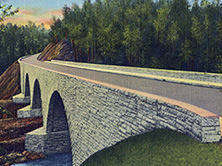 Bridge carrying Blue Ridge Parkway over the Linville River, Avery County (Durwood Barbour Collection of North Carolina Postcards, UNC-Chapel Hill)
Bridge carrying Blue Ridge Parkway over the Linville River, Avery County (Durwood Barbour Collection of North Carolina Postcards, UNC-Chapel Hill) Among the best-known historic bridges in North Carolina are the handsome stone-faced structures on the Blue Ridge Parkway. They are often found at the crest of the Blue Ridge where the Parkway crosses over or under state highways. They are sometimes mistaken for stone arches because of their stone veneers, but they are structural reinforced concrete arch, slab, or in most instances, rigid frame bridges
Construction on the 469-mile-long Blue Ridge Parkway began in 1935 as a New Deal works project to connect Shenandoah National Park in Virginia and Great Smoky Mountains National Park in North Carolina. It was completed in 1965, except for a missing link around Grandfather Mountain (Linn Cove Viaduct), which opened in 1987.
The concept of parkways originated in the early 20th century along suburban commuter routes and in metropolitan park systems. The Blue Ridge Parkway has classic parkway design attributes, such as circuitous routing, attractive views and vistas, controlled access, recreational pull-offs, rustic-style bridges, and travelers' facilities.
The National Park Service employed these ideas in several 1930s parkways in Virginia (Skyline Drive, Colonial Parkway, George Washington Parkway), but the Blue Ridge proved by far to be the longest and most ambitious. More than a motor road, the Blue Ridge Parkway was conceived to preserve and showcase attractive natural scenery, display traditional Appalachian culture, provide work for the region's population, and stimulate the depressed economy through tourism. The Parkway has been largely successful in its original goals and has had a significant impact on the development of the region.
The Blue Ridge Parkway has more than 168 bridges. Roughly half are faced in native stone that was usually quarried near the construction site. The stone facing was a hallmark of the rustic style employed by the Park Service, which dictated the use of materials that blended structures with their natural environment.
The bridges were a collaborative effort of engineers of the federal Bureau of Public Roads (predecessor of the Federal Highway Administration) and landscape architects and planners of the National Park Service.